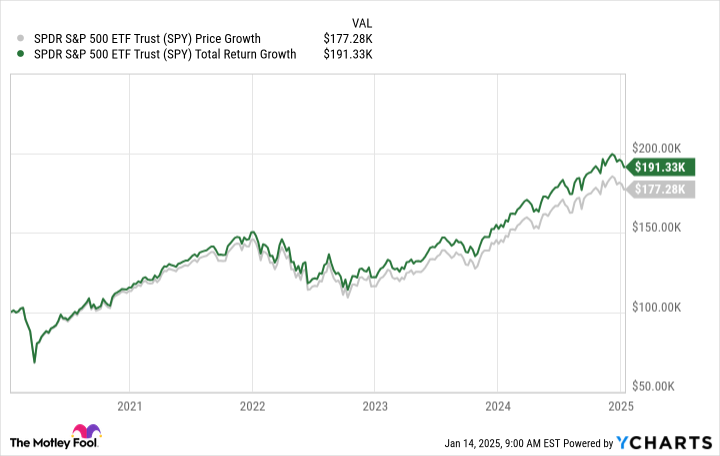Investing $100,000 into the stock market is a significant amount of money. You might expect that to be enough to eventually grow to $1 million, when looking at the long term — a period of 25 years or more.
But given how hot the stock market has been in recent years and the potential for a slowdown in the future, is mirroring the S&P 500 and gaining exposure to the top stocks really a surefire way to get to $1 million? Below, I’ll look at just how much a $100,000 investment may grow over the long haul.
The S&P 500 has amassed some incredible gains in recent years
Investing in the S&P 500 is a popular option for investors, and rightly so, since it gives you exposure to 500 of the top stocks in the world. These are blue chip investments, which are among the safest stocks you can hold in your portfolio. Through an exchange-traded fund (ETF) such as the SPDR S&P 500 ETF Trust (SPY 1.00%), investors can gain exposure to the broad index through just a single investment.
The S&P 500 is coming off a second straight year of more than 20% gains. If you’d invested $100,000 into the SPDR S&P 500 ETF Trust five years ago, that investment would be worth close to $200,000 now, when including dividends.
But therein lies the problem: The market’s hot performance means that there may be multiple years of slower returns ahead. Historically, the S&P 500 has only grown at an annual rate of around 10%; it’s been punching above its weight for consecutive years. While there was a sell-off in 2022, as you can see from the chart above, the overall trajectory remains fairly strong over the past five years.
What could a $100,000 investment be worth if the market slows down?
Predicting how the market will perform over a long timeframe is no easy task. Using 10% as an average is the easy option, but remember, that’s an average — it includes periods of both high returns and low returns. If you’re investing into the market at a time when it has been generating better-than-typical returns, it stands to reason that it may be due for periods of lower growth in the future.
To factor in the potential for lower growth, at least for some years, it may be a good idea to assume that the S&P 500 will grow at a rate of around 8%. That will give you a bit of a buffer for some bad years. Ideally, it will average a higher rate than that. However, this can ensure you’re factoring in some conservatism, which can be a good way to temper your expectations and minimize the risk of being too optimistic in your long-term forecast.
Assuming an 8% growth rate means that over a period of 25 years, an investment would grow to roughly 6.8 times its original value. That would convert a $100,000 investment into approximately $680,000 — well short of the $1 million mark. If the market performs slightly better and averages a 9% return, then your investment would grow to 8.6 times its value after 25 years, to around $860,000.
If you remain invested for more years, then you can still hit the $1 million mark. It would take 30 years of compounding at 8% for a $100,000 investment to grow to $1 million.
Does this mean it’s a bad time to invest in stocks?
You may be discouraged with the notion that even investing $100,000 today may not be enough to grow a portfolio to be worth $1 million in 25 years. But these are just estimates, and reality could turn out far different.
One way you can put yourself into a better position in the long run is to add to your investment regularly over the years, so that you’re buying into the market both when it’s doing well and when it’s underperforming. This will allow you to average down your cost if you’re buying at times when the market is experiencing a slowdown. Another option is to invest in ETFs that are more focused on growth stocks. These funds can come with a bit more risk, but can also potentially generate better returns than the broad market.
Ultimately, it’s generally a good move to invest in the stock market. You’ll likely grow your investment over time, whether it’s at 8%, 9%, 10%, or something else entirely. Investing in a fund that mirrors the S&P 500 can also ensure that you are keeping your risk relatively low.
David Jagielski has no position in any of the stocks mentioned. The Motley Fool has no position in any of the stocks mentioned. The Motley Fool has a disclosure policy.

















